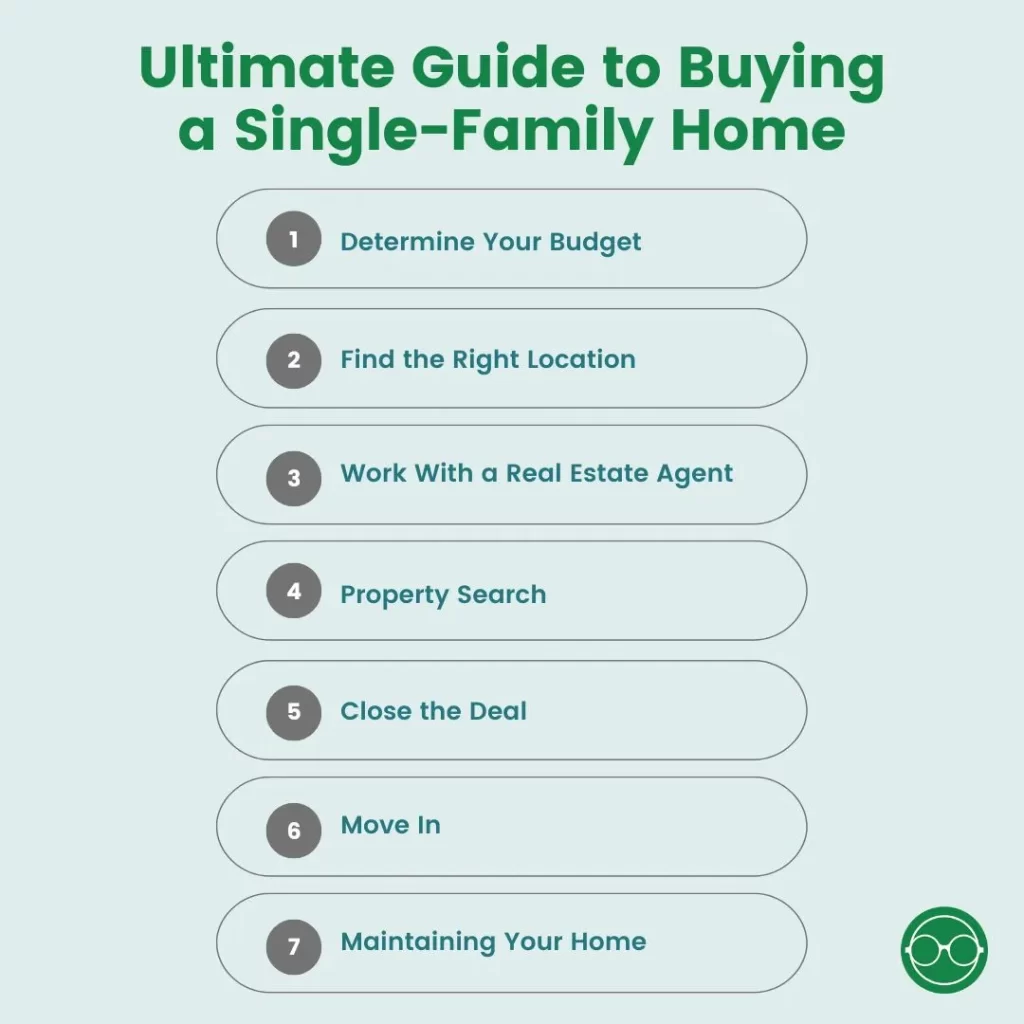This post may contain affiliate links. We may receive compensation when you click on links to those products at no additional cost to you. Read our full disclosure here.
Buying a single-family home is one of the biggest investments you will make in your life. It’s a decision that requires careful consideration and planning. This ultimate guide to buying a single-family home will provide you with step-by-step guidance on how to buy a single-family home. From determining your budget to finding the right location and property, we’ve got you covered.
Guide to Buying a Single-Family Home

1. Determine Your Budget
Before you start looking for a single-family home, it’s essential to determine your budget. This will help you know what you can afford, narrow down your options, and save time. Here are a few things you need to consider when determining your budget:
Calculate Your Income and Expenses
The first step in determining your budget is to calculate your income and expenses. You need to know how much money you have coming in each month and how much you are spending on essentials like rent, utilities, groceries, etc. Subtract your expenses from your income to get an idea of how much money you can afford to spend on a single-family home.
Consider Your Debt-to-Income Ratio
If you are planning to get a mortgage, you’ll need to know your debt-to-income ratio (DTI). The DTI is the percentage of your monthly income that goes toward paying off debt. Debt includes credit card debt, student loans, car loans, and any other loans you have. So if you make $100,000/year but make debt payments of $30,000/year, your DTI would be 30%.
Most lenders prefer a DTI ratio of 36% or less. The maximum DTI that most lenders will tolerate is 43% for mortgages, This means that your total monthly debt payments, including your mortgage payment, should not exceed 43% of your gross monthly income.
Nerdwallet has a handy calculator that can help you determine how much house you can afford based on your budget and DTI.
Get Pre-Approved for a Mortgage
Knowing your budget and DTI is also essential in getting pre-approved for a mortgage. Getting pre-approved is important as having a pre-approval letter when you make an offer to buy a house can help strengthen your offer and make you a more attractive buyer.
Sellers prefer buyers who have already been pre-approved for a mortgage, as this reduces the risk of a deal falling through due to financing issues.
Being pre-approved also gives you an idea of how much money you can borrow and what your monthly payments will be. To get pre-approved, choose your preferred lender and be prepared to submit the following documents:
- Pay stubs for the last two or three months
- W-2 forms for the last two or three years
- Tax returns for the last two or three years
- Bank statements for the last two or three months
- Proof of any other assets you might have, such as investments or retirement accounts
- Proof of any outstanding debts you might have, such as credit card balances or car loans
Do note that you are not bound to work with the lender that gave you pre-approval once you are ready to close. If another lender is willing to give you better terms when you are ready to close, you can always change!
2. Find the Right Location
Now that you know how much house you can afford, it’s time to look for one. The first thing we want to look for is the location of your home which is just as important as the property itself. You need to consider the following factors when choosing a location:
Consider Your Lifestyle
When choosing a location for your new home, consider your lifestyle. Do you want to live in the city, where you can easily access restaurants, shops, and entertainment? Or do you prefer a quieter suburban or rural setting, where you can enjoy more space and privacy? Think about your daily routine and what kind of community would be the best fit for your lifestyle.
Research Local Schools
If you have children or plan to in the future, research the local schools in the area. Look for schools with high ratings and good reputations. Even if you don’t have children, a home in a good school district can be a smart investment, as it can increase the value of your property.
Consider Commute Times
Think about how far you’re willing to commute to work or other activities. Consider the traffic patterns in the area and how they might impact your daily commute. If you plan to use public transportation, research the local transit options to ensure that they’re convenient and reliable.
Check Out Local Amenities
Check out the local amenities in the area, such as parks, restaurants, and shopping centers. Look for neighborhoods with amenities that match your interests and lifestyle. For example, if you’re an avid runner, look for neighborhoods with good running trails or parks. If you enjoy shopping, look for neighborhoods with a variety of stores and boutiques.
Research Safety and Crime Rates
Research the safety and crime rates in the area. Look for neighborhoods with low crime rates and good safety records. You can check local police reports and crime statistics to get an idea of the safety of the area. You can also utilize online tools like CrimeGrade.com can help you visualize crime in map form for when looking at neighborhoods.
Consider the Future
Finally, consider the future of the area you’re considering. Look for neighborhoods that are growing and have a strong economy. Consider factors such as new businesses and developments, population growth, and job opportunities. These factors can impact the long-term value of your investment.
3. Work with a Real Estate Agent
While you do not need a real estate agent to buy a single-family home, a real estate agent can be valuable to help you navigate the home-buying process, provide local market expertise, find properties that meet your needs, negotiate the best price, and handle the closing process.
The best part of this is that the real estate agent’s commission is typically paid for by the seller so you as the buyer don’t have to fork out anything. If you want do want to work with a real estate agent, here are some tips on choosing a good one:
- Look for Experience: When choosing a real estate agent, look for someone with experience in the local market. An experienced agent will have a better understanding of the local housing market and can help you find the right home at the right price. Look for agents who have been working in the area for several years and have a track record of successful sales.
- Check Their Credentials: Make sure that the agent you’re working with is licensed and registered with the state. You can check the state’s real estate commission website to verify their credentials. Also, look for agents who have additional certifications or designations, such as Accredited Buyer’s Representative (ABR) or Certified Residential Specialist (CRS).
- Ask for Referrals: Ask friends and family members for referrals to real estate agents they have worked with in the past. This can be a good way to find an agent who has a proven track record of success and who has provided excellent customer service.
- Interview Potential Agents: Before choosing an agent, take the time to interview potential candidates. Ask about their experience, credentials, and their approach to finding you the perfect home. Look for agents who are responsive, knowledgeable, and who communicate clearly.
- Understand Their Commission Structure: Make sure you understand how your agent will be compensated. In most cases, the seller pays the commission for both the buyer’s and seller’s agents, but there may be exceptions. Make sure you understand how the commission will be split and any fees that you’ll be responsible for.
4. Property Search
Now that you have determined your budget and location, it’s time to start your property search. If you hired a real estate agent, they can help you find properties that match your budget, location, and preference. They also have access to the Multiple Listing Service (MLS) and can provide you with detailed information about the properties you’re interested in.
Here are a few tips to help you find the right single-family home:
Identify Your Non-Negotiables
When searching for a single-family home, it’s important to identify your non-negotiables – the features or factors that are essential for you to have in a home. It may be helpful to make a list and prioritize them according to what is truly a make or break or what is more of a luxury to have. Do consider your lifestyle and be realistic based on your budget!
Examples of non-negotiables include:
- A minimum number of bedrooms and bathrooms
- A certain square footage
- A specific location, such as a certain neighborhood or school district
- A garage or off-street parking
- A certain style of architecture, such as a Victorian or Craftsman home
- A backyard or outdoor space
- A certain level of privacy or seclusion
- A specific price range
By identifying your non-negotiables, you can narrow down your search and focus on finding a home that meets your essential needs and requirements.
Attend Open Houses
Attending open houses is a great way to get a feel for the type of home you want to buy. This will also give you an opportunity to see the layout, design, and condition of the property. You can also ask the real estate agent questions about the home and get additional information that may not be available online.
When attending open houses, be sure to take note of the following:
- The overall condition of the property
- The exterior features like the roof, siding, windows, etc.
- The age and condition of the roof, HVAC system, and other major components
- The lighting in each room, including natural light
- The layout and size of the rooms
- The number of bedrooms and bathrooms
- The quality of the finishes and materials used throughout the home
- The presence of any major repairs or renovations that may be needed
- How much storage space there is
- The noise level inside and outside the home
Use Online Real Estate Websites
Online real estate websites like Zillow, Redfin, and Realtor.com can be great resources for finding properties that match your criteria. These websites allow you to filter your search by location, price range, number of bedrooms, and other factors to narrow down your options.
When using online real estate websites, be sure to:
- Check for new listings regularly
- Set up alerts for properties that match your criteria
- Read the property descriptions carefully
- Look at photos and virtual tours of the property
- Check the property’s history and listing price changes
Consider Off-Market Properties
In some cases, properties may not be listed on the MLS or online real estate websites. These off-market properties may be available through private sales, auctions, or other means. To find off-market properties, you can:
- Network with local real estate agents and investors
- Check local classifieds and community bulletin boards
- Drive around neighborhoods that interest you and look for “For Sale” signs
- Contact owners of properties that are not currently on the market to see if they are interested in selling
By using a combination of these methods, you can increase your chances of finding the perfect single-family home for you and your family.
5. Closing the Deal
Once you’ve found the right single-family home and negotiated a price with the seller, it’s time to close the deal. Closing a real estate transaction typically involves several steps, including:
- Hire a Real Estate Attorney: One of the first steps in closing the deal is to hire a real estate attorney. Your attorney will review the purchase contract, conduct a title search, and make sure all legal documents are in order.
- Secure Financing: Make sure your financing is in place before closing. If you were already pre-approved for a mortgage and are planning to use the same lender, this process should be pretty straightforward as they already have most of your information from the pre-approval process. This is an important step so make sure you know how to secure a mortgage first!
- Schedule a Home Inspection: Schedule a home inspection to identify any issues that may need to be addressed before closing. If any issues are identified, you can negotiate with the seller to have them fixed or receive a credit at closing.
- Obtain Homeowner’s Insurance: Obtain homeowner’s insurance to protect your investment in the property. Your lender will require proof of insurance before closing.
- Conduct a Final Walkthrough: Conduct a final walkthrough of the property to make sure it’s in the same condition as when you made your offer. If there are any issues, address them with the seller before closing.
- Prepare for Closing Costs: Prepare for closing costs, which typically range from 2-5% of the purchase price. These costs may include lender fees, title fees, and taxes.
- Sign Closing Documents: Review and sign the closing documents. Your attorney will explain each document and make sure everything is in order.
- Transfer Funds: Transfer the funds for the down payment and closing costs to the escrow account. Your attorney will oversee the transfer of funds and ensure that everything is done correctly.
- Receive Keys and Ownership: After all documents are signed and funds have been transferred, you’ll receive the keys to your new home and become the official owner.
Examples of potential challenges that could arise during the closing process include issues with the title, a delay in securing financing, or unforeseen repairs needed after the home inspection. Working closely with your real estate attorney and staying organized throughout the process can help you overcome these challenges and successfully close the deal on your single-family home.
6. Moving In
Once the deal is closed, it’s time to move into your new single-family home. This can be an exciting and overwhelming process, but with some careful planning and preparation, it can also be a smooth and stress-free experience. Some tips for making the most of your move-in day include:
- Labeling all of your boxes clearly so that you know where everything goes.
- Making sure that your utilities are turned on and your home is ready to live in.
- Hiring professional movers or enlisting the help of friends and family to make the moving process easier.
7. Maintaining Your Home
Owning a single-family home comes with a lot of responsibility, including the ongoing task of maintaining your property. Regular maintenance can help keep your home in good condition and prevent costly repairs down the line. Some tips for maintaining your single-family home include:
- Creating a regular maintenance schedule that includes tasks like cleaning gutters, changing air filters, and checking for signs of water damage.
- Making repairs promptly when problems arise, such as leaks or broken appliances.
- Investing in upgrades and improvements that can add value to your home, such as energy-efficient windows or a new roof.
Maintaining your home is honestly one of the pain points of home ownership vs renting as it can cost a lot more time and money than you think. I wrote more about the comparison in this article.
Final Thoughts
Buying a single-family home can be an exciting and rewarding experience, but it also requires careful planning and consideration. By following the steps outlined in this guide, you can increase your chances of finding the right home for your needs and budget.
If you feel overwhelmed, remember that professionals like such as real estate agents and mortgage lenders are on your team and would want to help you succeed, so don’t be afraid to lean on them if you need help or have any questions. Hopefully this was helpful and all the best in getting your dream home!
This post may contain affiliate links. We may receive compensation when you click on links to those products at no additional cost to you. Read our full disclosure here.






